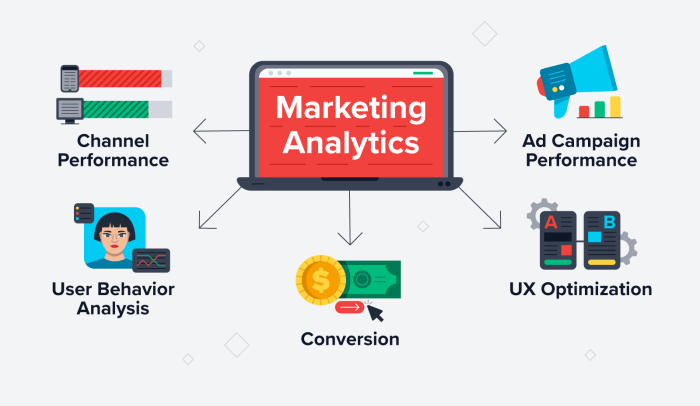Using Analytics in Marketing takes center stage, inviting you into a world of data-driven strategies that can revolutionize your marketing game. Get ready to dive into how analytics can transform the way businesses make decisions and execute campaigns.
Explore the different types of marketing analytics, the challenges of implementing analytics tools, leveraging data for targeted marketing, and measuring campaign performance to stay ahead in the competitive marketing landscape.
Introduction to Using Analytics in Marketing
Analytics in marketing is like having a secret weapon in your arsenal, helping businesses decode the mysterious world of consumer behavior and preferences. By diving into the data, marketers can uncover valuable insights that inform their strategies and decision-making process. Let’s break it down and see how analytics tools are the key to unlocking marketing success.
The Power of Analytics
- Analytics allows businesses to track and measure the performance of their marketing efforts in real-time, providing immediate feedback on what’s working and what’s not.
- By analyzing data on customer demographics, behavior, and interactions with the brand, businesses can tailor their marketing campaigns to target specific audiences more effectively.
- With the help of analytics, businesses can optimize their marketing spend by focusing on channels and tactics that deliver the best results, maximizing ROI.
Examples of Analytics Tools in Marketing Campaigns
- Google Analytics: This tool provides detailed insights into website traffic, user behavior, and conversion rates, helping businesses understand how visitors interact with their site.
- Social Media Analytics: Platforms like Facebook Insights and Twitter Analytics offer data on audience engagement, demographics, and content performance, allowing businesses to refine their social media strategies.
- Email Marketing Analytics: Tools like Mailchimp and Constant Contact track open rates, click-through rates, and subscriber behavior, enabling businesses to create more targeted and personalized email campaigns.
Types of Marketing Analytics

Marketing analytics play a crucial role in helping businesses make informed decisions and optimize their marketing strategies. There are various types of marketing analytics that companies can utilize to gain valuable insights into their target audience, campaign performance, and overall marketing effectiveness.
Customer Analytics
Customer analytics focus on understanding customer behavior, preferences, and buying patterns. By analyzing customer data, businesses can personalize their marketing efforts, improve customer satisfaction, and increase customer retention. For example, Amazon uses customer analytics to recommend products based on previous purchases and browsing history.
Social Media Analytics
Social media analytics involve monitoring and analyzing social media platforms to track engagement, sentiment, and trends. Companies use social media analytics to measure the impact of their social media campaigns, identify influencers, and understand customer sentiment towards their brand. For instance, Starbucks uses social media analytics to track customer feedback and engagement on platforms like Facebook and Instagram.
Web Analytics
Web analytics focus on tracking and analyzing website traffic, user behavior, and conversion rates. Businesses use web analytics to optimize their website performance, improve user experience, and increase online sales. For example, Google Analytics provides valuable insights into website traffic sources, user demographics, and popular pages to help businesses make data-driven decisions.
Predictive Analytics vs. Prescriptive Analytics
Predictive analytics involves using historical data and statistical algorithms to forecast future trends and outcomes. It helps businesses anticipate customer behavior, identify potential opportunities, and mitigate risks. On the other hand, prescriptive analytics goes a step further by providing actionable recommendations to optimize marketing strategies. It suggests the best course of action based on predictive insights to achieve desired outcomes.
Real-World Examples
– Netflix uses predictive analytics to recommend personalized content to its users based on their viewing history and preferences.
– Coca-Cola utilizes social media analytics to monitor brand mentions, engagement, and sentiment on platforms like Twitter and Instagram.
– Airbnb leverages web analytics to track user activity on its website, optimize search results, and enhance the booking experience for customers.
Implementing Analytics Tools

Implementing analytics tools in a marketing strategy is crucial for making informed decisions and optimizing performance. Companies need to follow specific steps to ensure a successful integration of analytics tools into their marketing processes.
Steps for Implementing Analytics Tools
- Define marketing goals: Before selecting any analytics tools, companies must clearly define their marketing goals and objectives to determine what data needs to be tracked.
- Choose the right analytics tool: Research and compare different analytics tools available in the market to find the one that best aligns with the company’s specific needs and budget.
- Implement tracking codes: Integrate tracking codes into the company’s website and marketing channels to start collecting data on user interactions and behaviors.
- Set up dashboards and reports: Create customized dashboards and reports to visualize and analyze the data collected from the analytics tools in a meaningful way.
- Monitor and adjust: Continuously monitor the analytics data, analyze the results, and make adjustments to the marketing strategy based on insights gained.
Challenges in Integrating Analytics Tools
- Data privacy and compliance: Companies need to ensure that the data collected and analyzed through analytics tools comply with data privacy regulations to avoid legal issues.
- Integration with existing systems: Integrating new analytics tools with existing marketing systems and processes can be challenging and may require technical expertise.
- Skill gap: Companies may face challenges in finding employees with the necessary skills and knowledge to effectively use analytics tools and interpret data.
Tips for Selecting the Right Analytics Tools
- Identify specific needs: Determine the specific data points and metrics that are essential for measuring the success of the marketing strategy.
- Consider scalability: Choose analytics tools that can scale with the company’s growth and evolving marketing needs.
- Seek user-friendly interfaces: Select tools with intuitive interfaces that are easy to use and understand for all team members involved in the analytics process.
- Look for customization options: Opt for analytics tools that offer customization options to tailor the data tracking and reporting to the company’s unique requirements.
Leveraging Data for Targeted Marketing
Data from analytics tools plays a crucial role in creating targeted marketing campaigns. By analyzing customer behavior, preferences, and interactions with the brand, marketers can tailor their messages and promotions to specific segments, increasing the relevance and effectiveness of their marketing efforts.
Role of Customer Segmentation, Using Analytics in Marketing
Customer segmentation is essential in using analytics for personalized marketing. By dividing customers into distinct groups based on demographics, behavior, or preferences, marketers can create targeted campaigns that resonate with each segment. This allows for more personalized messaging, leading to higher engagement and conversion rates.
- Segmenting customers based on purchase history can help identify loyal customers who might benefit from exclusive offers or rewards.
- Demographic segmentation can help tailor marketing messages to different age groups, genders, or locations, ensuring relevance and resonance with the target audience.
- Behavioral segmentation can identify customers who have shown interest in specific products or services, allowing for targeted promotions to encourage conversions.
Success Stories
Many businesses have achieved higher ROI through targeted marketing using analytics. For example, a clothing retailer used customer data to identify segments interested in sustainable fashion. By creating personalized campaigns highlighting eco-friendly products, they saw a significant increase in sales from those segments. Another success story involves a food delivery service that analyzed customer preferences to offer personalized recommendations, resulting in a boost in order frequency and customer satisfaction.
Measuring Marketing Campaign Performance
Marketing campaigns are crucial for businesses to reach their target audience and drive sales. Analyzing the performance of these campaigns through key performance indicators (KPIs) helps marketers understand what is working and what needs improvement.
Key Performance Indicators (KPIs)
- Conversion Rate: This KPI measures the percentage of website visitors who take a desired action, such as making a purchase or signing up for a newsletter. A higher conversion rate indicates the effectiveness of the campaign in driving user engagement.
- Click-Through Rate (CTR): CTR measures the percentage of people who click on a specific link in an email, ad, or webpage. A high CTR signifies that the campaign message is resonating with the target audience.
- Return on Investment (ROI): ROI calculates the revenue generated from the campaign compared to the cost of running it. A positive ROI indicates that the campaign is profitable and worth the investment.
Interpreting Analytics Data for Optimization
- Identifying Trends: Analyzing data trends helps marketers understand what strategies are working and which ones need adjustment. By tracking metrics over time, marketers can make informed decisions to optimize their campaigns.
- A/B Testing: Conducting A/B tests allows marketers to compare different versions of a campaign to see which one performs better. By analyzing the results, marketers can refine their strategies for maximum impact.
- Segmentation Analysis: Segmenting data based on demographics, behavior, or other variables helps marketers target specific audience segments more effectively. Understanding the preferences of different segments can lead to personalized and tailored marketing campaigns.
Examples of Adjusting Campaigns based on Analytics Data
- Company A noticed a low conversion rate on their website and decided to analyze user behavior using analytics tools. By identifying bottlenecks in the checkout process, they streamlined the steps and saw a significant increase in conversions.
- Company B ran an email marketing campaign with different subject lines to test engagement levels. Analyzing the open rates and click-through rates, they discovered that personalized subject lines led to higher interaction with their emails. As a result, they adjusted their future campaigns to include more personalized content.
- Company C used social media analytics to track engagement metrics on their posts. By analyzing which types of content resonated most with their audience, they were able to create more engaging and shareable posts, leading to increased brand awareness and customer loyalty.





